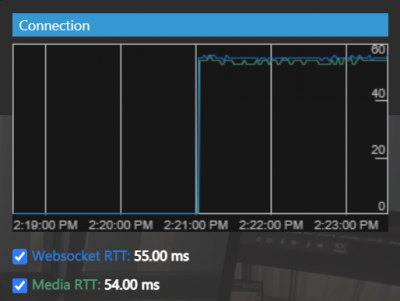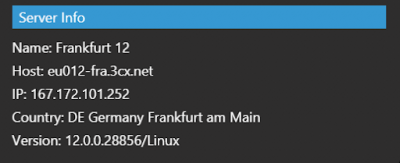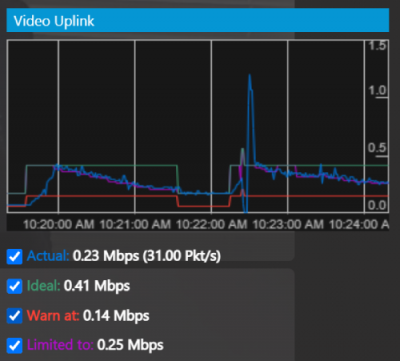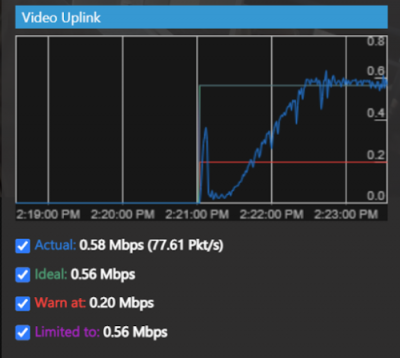Videoconferencing, of course, depends on the equipment you are using - a webcam and microphone or speakerphone. Light also greatly affects the image quality, and especially the overall illumination of the room. Remember, a webcam is a simpler device than a $ 1000 professional camcorder.
The stability of the internet connection also has a big impact on the quality of the conference. Sometimes it is even more important than the hardware. An unstable connection will negate all the benefits of expensive conference room equipment.
Video Conferencing Quality - Profiles
The 3CX Video Conferencing Host allows you to set 3 levels of conference quality - low (800 kbps), balanced (1800 kbps) and high (3500 kbps). Each level determines the amount of video information that the participant sends to the conference.
Inbound traffic to a participant
The diagram below shows the inbound bandwidth for each participant in a conference. At all quality levels, the increase in bandwidth is not linear. That is, the traffic volume does not increase in proportion to the connecting participants. The reason for this will be clear from the following diagram showing the bandwidth requirements for outbound traffic and the ratio of inbound to outbound member traffic based on the total number of members.

Outbound traffic from a participant
The second diagram shows the outbound bandwidth required by each participant in the conference. You can see that the more participants, the lower the specific bandwidth required by each participant. It looks strange, but it's easy to explain.
The more conference participants, the more video tiles are displayed in the 3CX interface. Although there are more of them, each tile takes up less screen space. Accordingly, less detail is conveyed in a small picture and the requirements for image quality are reduced.

3CX uses this opportunity and instead of continuing to transmit full traffic for a small picture, it dynamically reduces the bandwidth. Typically, the larger the image size of the conference participant, the more bandwidth they need. Conversely, with an increase in the number of displayed images, the flow from the participant decreases.
Network latency
Latency shows how long it takes for your video / audio to be delivered from you to the video conferencing server, and how long it takes for video / audio from others to be delivered to you. The accepted normal value is up to 80-120 msec. Of course, the lower the latency, the better, since this reduces the likelihood of an effect when the conversations of the participants begin to overlap one another.
How to reduce latency?
The distance between you and our cloud video conferencing servers has a big impact on latency. Therefore, when setting up a PBX, select the correct region for users. Then they will be able to use the closest 3CX server (MCU) to them.
At any time, you can check the delay and other statistics of the conference by clicking on the gear icon, and then on the button with the diagram.
Good quality link statistics are shown below. If you see large fluctuations here, it is possible that someone is uploading large files on your network.

How do I control network latency during a conference?
The bottom of the WebMeeting statistics window shows the 3CX server you are connected to, including its location. Make sure to use the closest server for the region of the conference participants. If an unsuitable server is selected, change it in the 3CX management interface, in the Settings → Conferences → Video conferencing tab.

Bandwidth
When using various video conferencing products, sometimes you may observe that the video from the participants starts to freeze, jerk, or “break up into squares”. 3CX has practically eliminated this drawback by implementing its own unique algorithms that are not available in other platforms:
- there is an optimal (Ideal) bandwidth, which is constantly needed to transmit video in the best quality;
- there is your actual (Actual) bandwidth - the traffic that you are actually transmitting at the moment;
- you may be forced to be Limited to a lower bandwidth for the reasons stated in the previous articles.
Dynamic bandwidth reduction
Let's give an example where the video quality can be dynamically reduced.
You are using a Balanced conference quality profile that maintains a maximum upstream bandwidth of ~ 700 kbps. This is the extremely necessary traffic for this profile - you simply cannot (does not make sense) receive / send more video data.
Let's say you are holding a conference with a user who cannot receive a ~ 700 kbps stream due to restrictions on his channel or other problems on his side. If this is the case, 3CX will dynamically reduce your outgoing traffic slightly.
The stream will be reduced so that the receiving side does not “choke on” video data (manifests itself as loss of frames and voice). At the same time, the decline in quality will not be strong enough to become unacceptable. 3CX automatically detects the sweet spot!

Note the lines Actual and Limited to. If the actual traffic is below the maximum allowable, this indicates that either you or another participant has problems with the network or equipment, and the bandwidth is automatically “squeezed” by 3CX. In this case, the requirements for the optimal (Ideal) bandwidth are also automatically reduced.
Automatic support for conference quality
Of course, network problems can be temporary, and your interlocutor will soon be ready to receive the same ~ 700 kbps again.
3CX Video Conferencing “remembers” that you could previously send 700 kbps and tries to gradually increase the bandwidth while monitoring for errors. If the ramp-up detects lost packets or other glitches, the quality is dynamically downgraded again, but not so much this time.
The process is repeated until a new optimal bandwidth is found. The screenshot below shows an example of such a smooth flow increase. The system will also set a new Ideal setting that best suits the current situation.

If the actual bandwidth drops to the Warn at red line and stays at this level for more than 1 minute, the user will see a warning message asking to change the conference quality profile or disable video transmission altogether.
What other important factors for quality communication have we not mentioned? Write in the comments.
In the next article, we will tell you more about web meetings in V18 3CX, but for now a minute of vanity: 3CX was named the # 1 provider of VoIP telephony services and software solutions for web conferencing by Digital.com (London). Hooray!